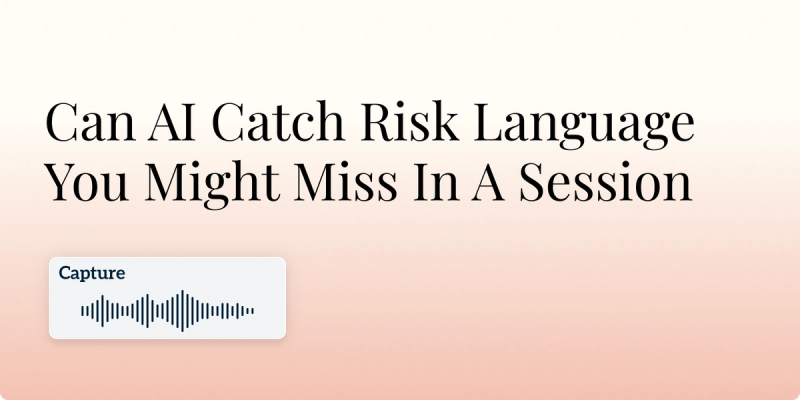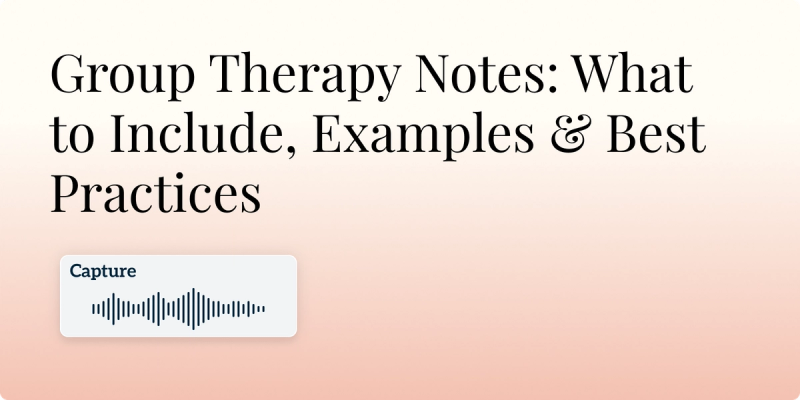
Can AI Catch Risk Language You Might Miss In A Session?

In the flow of a therapy session, your attention is a multilayered instrument. You are simultaneously building rapport, tracking complex narrative threads, formulating clinical hypotheses, and holding emotional space for your patient. This cognitive load is a testament to your skill, but it also has a hard limit. Subtle linguistic cues– a passive metaphor for self‑harm, a veiled expression of intent, a shift into hopelessness– can, despite our best efforts, slip through the cracks of human attention.
However, introducing an AI tool can act as a systematic safety net. By leveraging the precision of Natural Language Processing (NLP), AI is being trained to identify risk language in therapy, offering a second layer of analysis to help ensure patient safety. Explore how utilizing AI therapy notes in your practice could potentially save you from missing risk language.
How NLP Deciphers Language For Risk
To understand how AI can catch risk language, we must first look under the hood at its core technology: Natural Language Processing (NLP). In essence, NLP is a branch of artificial intelligence that enables machines to read, decode, and understand human language in a structured and meaningful manner. It moves far beyond simple pattern matching and into the realm of contextual comprehension.
Beyond Keyword Matching
Early attempts at automated risk detection rely on a static keyword list. Flag a word like “suicide”, “kill”, or “overdose” and trigger an alert. While this can catch explicit statements, it is a blunt instrument with significant flaws. It fails with:
- Metaphor and Idiom: “I'm at the end of my rope”, or “I just want the pain to stop.”
- Passive or Abstract Language: “I sometimes think everyone would be better off without me.”
- Denial and Ambivalence: “I wouldn't hurt myself, but the thoughts are so loud.”
Modern clinical AI leverages NLP techniques to overcome these limitations. It doesn't just look for words; it analyzes the intricate threads of language, context, and meaning.
The Technical Mechanisms in AI Therapy Notes.
Here's a breakdown of the key NLP processes that work to identify risk:
1. Sentiment Analysis
This technique assesses the emotional valence (the positivity or negativity) of statements. Rather than taking a single snapshot, advanced models track sentiment across a session.
Example: An AI might assign a sentiment score on a scale from ‑1 (profoundly negative) to +1 (profoundly positive). A patient's language might hover around ‑0.5 for most of the session (reflecting their depression).
However, if a segment suddenly drops to a sustained ‑0.9, filled with phrases like “utterly hopeless”, “there's no point in trying”, and “nothing will ever change,” the AI flags this sharp negative shift. This indicates a potential escalation in despair, a key risk factor for self‑harm, even in the absence of a specific plan.
2. Named Entity Recognition (NER)
NER is an information extraction technique that identifies and categorizes key “entities” (nouns) into predefined groups, such as Person, Organization, Location, and, crucially for therapy, Clinical Concepts.
Example: In the sentence, “The voice is telling me my husband is poisoning the bottle,” a clinical NER model would:
- Tag “the voice” as SYMPTOM_HALLUCINATION.
- Tag “my husband” as “PERSON_FAMILY.
- Tag “the bottle” as OBJECT_SUBSTANCE.
This structured data immediately highlights a potentially psychotic and dangerous situation involving a specific person and a method, providing critical context that a simple keyword scan would miss.
3. Syntactic and Semantic Parsing
This is where NLP moves “what” to “how” it is said.
- Syntactic parsing analyzes the grammatical structure of a sentence; the relationship between words (subject, verb, object)
- Semantic Parsing delves into the meaning and logical relationships between those words.
Example: Consider these two sentences:
A: “I would never hurt myself.”
B: “I sometimes think about what it would be like to not be here anymore.”
Syntactically, Sentence A is a definitive denial. Sentence B is a complex, contemplative statement.
Semantically, Sentence A’s meaning is clear and low‑risk. Sentence B, however, uses abstract phrasing (“not be here anymore”) as a euphemism for death or suicide. The AI is trained to recognize this semantic equivalence, allowing it to flag Sentence B for passive suicidal ideation, while correctly ignoring Sentence A.
4. Topic Modeling
Topic Modelling is an unsupervised machine learning technique that analyzes a corpus of text (like a session transcript) to automatically discover the recurring, underlying themes or topics that permeate the conversation.
Example: An AI might process a full session transcript and identify that the language clusters strongly around three latent topics:
- Topic 1: Characterized by words like burden, easier, family, trouble, and sorry.
- Topic 2: Characterized by words like alone, isolated, empty, disconnected, and nobody.
- Topic 3: Characterized by words like escape, sleep, quiet, peace, and end.
Individually, these words might not trigger an alert. But when the model identifies that the conversation is dominantly composed of “Topic 1” (Burden) and “Topic 3” (Escape), it creates a powerful, aggregate signal of risk that is greater than the sum of its parts. It reveals a patient's core cognitive‑emotional framework of feeling like a burden and seeking an escape– a high‑risk combination.
By integrating these mechanisms, AI transforms a raw transcript into a structured, analyzed dataset, highlighting not just what was said, but the subtle, clinically significant patterns in how it was said. This provides the therapist with a depth of analytical insight that was previously impossible to achieve in real time.
Technical Examples Of AI-Caught Risk
To move from abstract potential to concrete utility, let's examine how these NLP mechanisms work during simulated session segments. These examples illustrate the nuanced risk language in therapy that an AI safety net is designed to catch.
1. Passive vs. Active Suicidal Ideation
The Clinical Exchange:
Patient: “Lately, the pain is just constant. You know? It's like a weight that never lifts. I look at my family and just think…it would be easier for everyone if I just…faded away.”
What a Clinician Might Hear:
A patient expressing profound exhaustion and hopelessness, common in severe depression. The phrase “faded away” is abstract and may be interpreted as a wish for relief rather than a direct threat, potentially leading a clinician focused on the core affect of depression to miss the specific suicidal undertone.
What the AI flags and how:
- Sentiment Analysis: The entire segment receives a negative score. The system notes the sustained negative emotional load.
- Semantic Parsing and NER: The AI identifies “easier for everyone” as a key phrase and classifies it under the THEME_BURDEN entity. It simultaneously parses “faded away” and, through its training on clinical language, maps this metaphor semantically to concepts of CEASING_TO_EXIST or DEATH_IDEATION.
- Topic Modelling: The language clusters with other known markers of passive suicidal ideation (PSI) in its model.
The Alert:
The co‑occurrence of INTENSE_NEGATIVE_SENTIMENT + THEME_BURDEN + METAPHOR_DEATH triggers a risk alert for passive SI. The clinician sees the specific phrases highlighted with a rationale: “Flagged for passive suicidal ideation: high burden theme detected with metaphorical reference to cessation.”
2. Escalating Intent in Harm to Others
The Clinical Exchange:
Patient: “It's the same thing every day with my boss. He's deliberately undermining me in meetings. I just can’t take it anymore. I’m not going to just sit here and let him destroy my career. He's going to get what's coming to him, I swear.”
What a Clinician Might Hear:
A patient venting about significant work stress and frustration. While the threat is vague, a clinician might (rightfully) be concerned but may focus on the interpersonal conflict and stress management, potentially underestimating the imminence or specificity of the risk.
What the AI Flags and How:
- Named Entity Recognition (NER): The model identifies “my boss” as a specific PERSON_SPECIFIC entity, moving the threat from a generalized group to an identified individual.
- Semantic Parsing: The phrase “can’t take it anymore” is recognized as a common linguistic marker of ESCALATION_INTENT. “Get what's coming to him” is parsed not as a common idiom, but as a VAGUE_THREAT in this context of high frustration and a named target.
- Temporal Analysis and Session History: The AI compares this language to the patient's baseline from previous sessions. A first-time mention is noted, but a pattern of increasing agitation and fixation on the “boss” entity would significantly raise the risk score.
The Alert
The combination of SPECIFIC_TARGET + ESCALATION_INTENT + VAGUE_THREAT triggers an alert for potential risk of violence. The flag might read: “Flagged for potential harm to others: specific individual named with escalating and threatening language.”
The Clinical Safety Net: Integrating AI Flags Into Practice
The true value of this technology is realized only when it is seamlessly integrated into a clinician‑led workflow. This is a process of augmentation, not automation. The AI provides a structured hypothesis; the clinician provides the context, judgment, and decision‑making needed for catching risk language.
The Workflow in Practice
Here is how the flagging system integrates into a typical clinical process:
- Session Conclusion and Processing: The session ends, and the audio recording is automatically transcribed. The raw transcript is processed by the AI’s NLP models in an encrypted environment.
- Flag Generation and Rationale: The system generates a report alongside the transcript. Specific phrases are highlighted and tagged with a risk level (low, moderate, high)
- Clinician Review: The therapist reviews the flags using their clinical judgment to contextualize the alert, triage its importance, and decide on the appropriate course of action.
This workflow transforms the AI from a black box into a powerful clinical assistant, ensuring the subtle risks are systematically identified, considered, and acted upon with the full weight of professional expertise.
Ethical Considerations And Limitations
Adopting AI therapy notes requires navigating its ethical landscape with clarity. Key concerns for practitioners include:
- Confidentiality and Data Security: Patient data must be protected with end-to-end encryption (in transit and at rest) and anonymization techniques on HIPAA-compliant platforms. This ensures the sanctity of session content is preserved.
- Bias in AI: Models can perpetuate societal biases if trained on non-representative data. It's critical to use tools that are clinically validated and undergo routine bias auditing to ensure equitable performance across diverse populations.
- False Positives: The system is calibrated for high sensitivity, meaning it may flag benign language (e.g., “that meeting killed me”). This is by design. The clinician's role is to be the final filter, applying context and judgment to separate signal from noise.
- The Irreplaceable Human Element: AI is blind to the core of therapy: non-verbal cues, therapeutic alliance, and clinical intuition. It is a tool for data analysis, not a replacement for human connection and judgment.
Conclusion
AI in therapy is not about replacing clinicians but augmenting them. Natural Language Processing provides a systematic, safety net, analyzing linguistic nuance to flag subtle risks that human attention might miss. This partnership empowers providers with deeper insights, enhancing documentation and informing clinical decisions to improve patient safety and outcomes. As the technology evolves, this synergy between human expertise and algorithmic precision will only deepen, fortifying our collective mission to provide effective and safe mental health care.
Frequently Asked Questions
ABOUT THE AUTHOR
Dr. Eli Neimark
Licensed Medical Doctor
Reduce burnout,
improve patient care.
Join thousands of clinicians already using AI to become more efficient.

Are AI Scribes Worth It? 2026 Data, ROI Math, Risks & Best Options
Are AI scribes worth it in 2026? See peer‑reviewed results, real costs, HIPAA & risk checks, and a simple ROI calculator - plus who should (and shouldn’t) buy.

Group Therapy Notes: What to Include, Examples & Best Practices
Learn what to include in group therapy notes, with examples, formats, and best practices to improve clinical accuracy and ease documentation.

What Is an AI Medical Scribe?
Discover how AI Medical Scribes automate clinical documentation, reduce physician burnout, and improve patient care.

